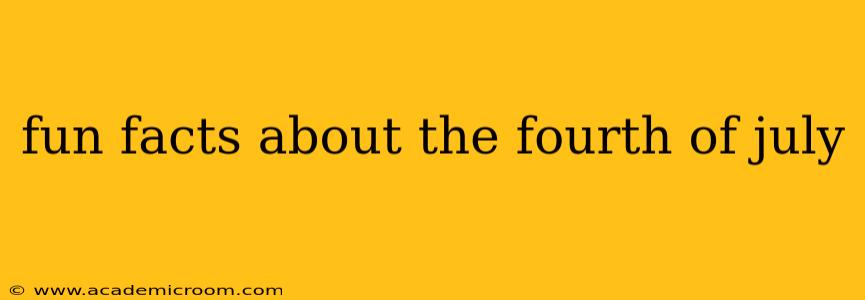The Fourth of July, Independence Day, is more than just fireworks and backyard barbecues. It's a day steeped in history, brimming with fascinating stories and little-known details. This post delves into some fun facts that will add a spark to your understanding of this cherished American holiday.
What is the Fourth of July?
Before we dive into the fun facts, let's establish a baseline. The Fourth of July commemorates the adoption of the Declaration of Independence on July 4, 1776. This document declared the thirteen American colonies independent from Great Britain, marking a pivotal moment in American history and the birth of the United States of America.
Fun Facts That Will Surprise You
Here are some fun facts about the Fourth of July that might surprise you:
-
The Declaration wasn't actually signed on July 4th: While the Declaration of Independence was adopted on July 4, 1776, the final engrossed (handwritten) copy wasn't signed until August 2nd. Many of the signers weren't even present in Philadelphia on July 4th.
-
John Adams predicted massive celebrations: In a letter to his wife Abigail, John Adams predicted that July 2nd (the day Congress voted for independence) would be celebrated with "pomp and parade, with shows, games, sports, guns, bells, bonfires and illuminations from one end of this continent to the other" - a pretty accurate prediction, though the date was slightly off!
-
It wasn't immediately a national holiday: It took quite some time for the Fourth of July to become the widespread national celebration we know today. Early celebrations were more localized and varied greatly in style. It wasn't until the 19th century that it truly solidified as a major national holiday.
-
Fireworks weren't always part of the celebrations: While fireworks are now synonymous with the Fourth of July, their inclusion in celebrations wasn't consistent in the early years. The tradition grew gradually over time.
-
The Liberty Bell didn't ring on July 4th (probably): Popular legend says the Liberty Bell rang to announce the signing of the Declaration of Independence, but historical evidence suggests it's unlikely it rang on that specific day.
Frequently Asked Questions (FAQs) about the Fourth of July
Here are some common questions people ask about the Fourth of July, answered in detail:
How was the Declaration of Independence written?
The Declaration of Independence was primarily written by Thomas Jefferson, but it was revised and refined by the Committee of Five, which included John Adams, Benjamin Franklin, Roger Sherman, and Robert Livingston. The final document represents the collaborative effort of several key figures.
What were some of the major events leading up to the Declaration of Independence?
Several key events precipitated the Declaration, including the Stamp Act, the Boston Tea Party, and the battles of Lexington and Concord. These events highlighted growing tensions between the colonies and Great Britain, ultimately leading to the decision to declare independence.
Why is the Fourth of July celebrated with fireworks?
The use of fireworks on the Fourth of July is linked to the celebratory traditions of the time. Fireworks provided a visually spectacular way to express joy and patriotism. The tradition has endured and evolved, becoming a core element of modern Independence Day celebrations.
When did the Fourth of July become a federal holiday?
The Fourth of July officially became a federal holiday in 1870. Before that, celebrations were more regional and less consistently observed.
What are some traditional Fourth of July activities?
Besides fireworks, common activities include parades, barbecues, picnics, family gatherings, and various outdoor games and activities. The day emphasizes community celebration and national pride.
Conclusion
The Fourth of July is a holiday rich in history and tradition, filled with fascinating stories beyond the familiar fireworks and barbecues. Understanding these lesser-known facts enriches the experience of celebrating this significant day in American history. Happy Independence Day!
